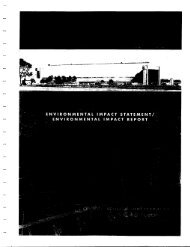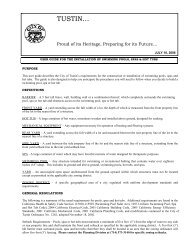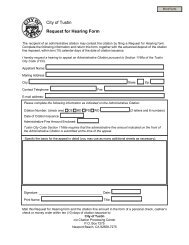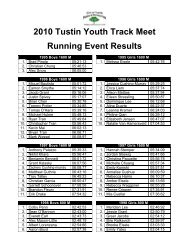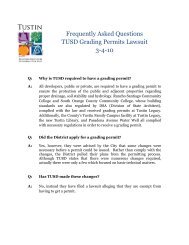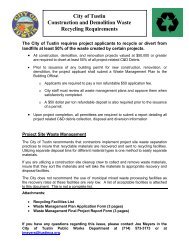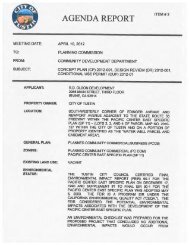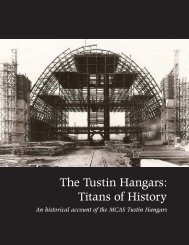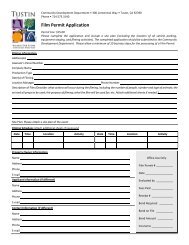Report - City of Tustin
Report - City of Tustin
Report - City of Tustin
You also want an ePaper? Increase the reach of your titles
YUMPU automatically turns print PDFs into web optimized ePapers that Google loves.
The <strong>City</strong> also maintains control aver the actual real estate licensing and business<br />
terms and conditions under which a cell site on any city owned property would be<br />
subsequently licensed by the <strong>City</strong> after it is location and design is approved by the<br />
Community Development Department or legislative body as may be required<br />
pursuant to <strong>City</strong> codes However the <strong>City</strong> may not reject a zoning approval <strong>of</strong> a cell<br />
site or tower due to health concerns under federal law<br />
Q Are there health dangers<br />
from cell sites and or towers<br />
A<br />
There is no credible US scientific evidence which attributes negative health<br />
effects to exposure to wireless transmissions from cell site and towers<br />
www fcc pov cqb<br />
consumerfacts rfexposurehtml<br />
The federal government also regulates wireless transmissions through the<br />
Occupational Safety and Health Administration OSHA and the Federal<br />
Communications Commission FCC In 1996 the FCC adopted guidelines for<br />
evaluating human exposure to radio frequency RF fields from fixed transmitting<br />
antennas such as those used for cellular sites These guidelines are used by all<br />
wireless carriers in testing to ensure their compliance with OSHA and FCC<br />
requirements The FCC guidelines for cellular sites are identical to those<br />
recommended by third party agencies the National Council on Radiation Protection<br />
and Measurements NCRP and similar to guidelines recommended by American<br />
National Standards Institute and the Institute <strong>of</strong> Electrical and Electronics Engineers<br />
The Telecommunications Act <strong>of</strong> 1996 created the regulatory environment that<br />
provides for ubiquitous wireless coverage in the United States Because the<br />
Telecommunications Act was enacted by Congress and because federal agencies<br />
regulate wireless transmissions federal law pre empts any State or local laws<br />
concerning telecommunications The Telecommunications Act provides that cell<br />
tower applications may not be rejected by municipal governments on the basis <strong>of</strong><br />
health concerns in part because there is no scientific evidence to suggest that cell<br />
towers present risk to health Although residents may have concerns about health<br />
effects related to cell towers the <strong>City</strong> cannot legally reject zoning applications based<br />
on this factor<br />
There have been numerous studies done measuring the levels <strong>of</strong> radio frequency<br />
exposure near typical cellular and wireless carrier installations especially those with<br />
tower mounted antennas These studies have concluded that ground level radio<br />
frequencies and energy power densities are thousands <strong>of</strong> times less than the limits<br />
for safe exposure established by the Federal Communications Commission FCC<br />
Safety guidelines already in place establish minimum requirements that must be<br />
followed by the cell carrier industry This makes it extremely unlikely that a member<br />
<strong>of</strong> the general public could be exposed to radio frequency levels in excess <strong>of</strong> FCC<br />
guidelines due to cellular or wireless antennas located on towers or monopoles<br />
FCC guidelines establish Maximum Permissible Exposure MPE for use by the<br />
wireless carriers in the development and placement <strong>of</strong> their antennas and



